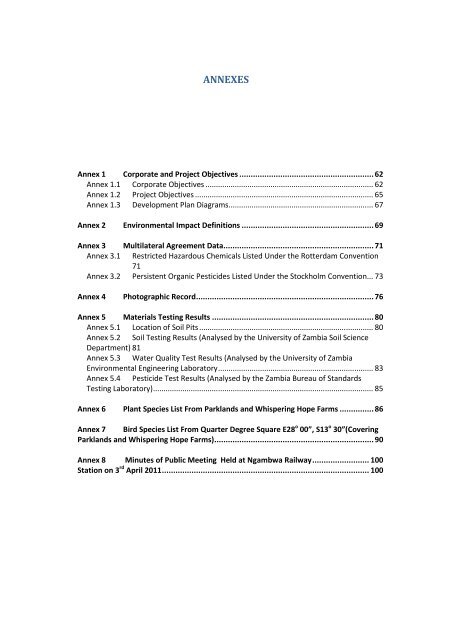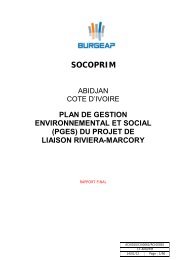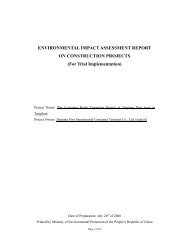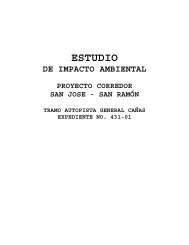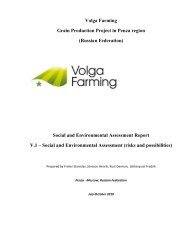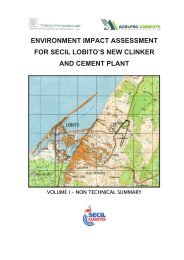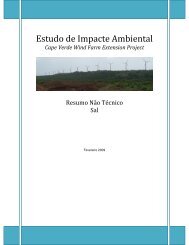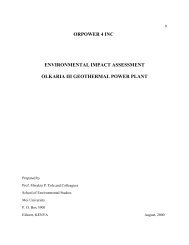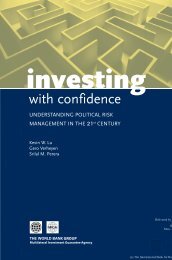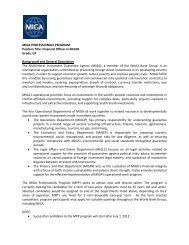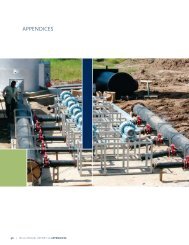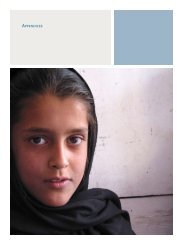Environmental Impact Statement Annexes - MIGA
Environmental Impact Statement Annexes - MIGA
Environmental Impact Statement Annexes - MIGA
You also want an ePaper? Increase the reach of your titles
YUMPU automatically turns print PDFs into web optimized ePapers that Google loves.
ANNEXES<br />
Annex 1 Corporate and Project Objectives ........................................................... 62<br />
Annex 1.1 Corporate Objectives ................................................................................ 62<br />
Annex 1.2 Project Objectives ..................................................................................... 65<br />
Annex 1.3 Development Plan Diagrams ..................................................................... 67<br />
Annex 2 <strong>Environmental</strong> <strong>Impact</strong> Definitions .......................................................... 69<br />
Annex 3 Multilateral Agreement Data .................................................................. 71<br />
Annex 3.1 Restricted Hazardous Chemicals Listed Under the Rotterdam Convention<br />
71<br />
Annex 3.2 Persistent Organic Pesticides Listed Under the Stockholm Convention ... 73<br />
Annex 4 Photographic Record .............................................................................. 76<br />
Annex 5 Materials Testing Results ....................................................................... 80<br />
Annex 5.1 Location of Soil Pits ................................................................................... 80<br />
Annex 5.2 Soil Testing Results (Analysed by the University of Zambia Soil Science<br />
Department) 81<br />
Annex 5.3 Water Quality Test Results (Analysed by the University of Zambia<br />
<strong>Environmental</strong> Engineering Laboratory .......................................................................... 83<br />
Annex 5.4 Pesticide Test Results (Analysed by the Zambia Bureau of Standards<br />
Testing Laboratory) ......................................................................................................... 85<br />
Annex 6 Plant Species List From Parklands and Whispering Hope Farms ............... 86<br />
Annex 7 Bird Species List From Quarter Degree Square E28 o 00”, S13 o 30”(Covering<br />
Parklands and Whispering Hope Farms) ...................................................................... 90<br />
Annex 8 Minutes of Public Meeting Held at Ngambwa Railway ......................... 100<br />
Station on 3 rd April 2011 ........................................................................................... 100
Annex 1 Corporate and Project Objectives<br />
Annex 1.1 Corporate Objectives<br />
Overview:<br />
Chobe Agrivision is part of an investment company (the “Fund”) whose vision is to<br />
create world-class farming operations and integrated businesses across the agricultural<br />
value chain, and to leave a legacy of responsible commercial agricultural practices in<br />
the region. The company’s goals for the project include:<br />
- Achieving economies of scale through the creation of service businesses<br />
along the value chain;<br />
- Focusing on exporting food cross-border within Africa, building<br />
infrastructure throughout the region, and providing skill transfer at the<br />
local level;<br />
- Acquiring brown field sites and significantly boost productivity,<br />
increasing production through a combination of farming techniques<br />
(improving soil quality through conservation tillage and crop rotation) and<br />
irrigation methods;<br />
- Creating jobs and improving conditions for the farming workforce and<br />
their families;<br />
- Offering a source of training within communities through outreach<br />
programmes and formal education, cultivating next generation of farm<br />
management from within the local communities;<br />
- Providing small-scale farmers routes to market and access to<br />
infrastructure such as storage and milling.<br />
<strong>Environmental</strong>, Social Responsibility and <strong>Environmental</strong> Risk Management<br />
Approach<br />
The Fund shall use reasonable efforts to ensure that the following policies and<br />
guidelines are enforced.<br />
The Fund’s investments will strive to enhance economic development and have a<br />
positive impact on social advancement in the following manner:<br />
(i) by fostering broad-based citizen economic empowerment in host countries<br />
beginning with indirect empowerment through employment, skill<br />
development, technology transfer and socio-economic capacity building.<br />
This is intended ultimately to lead to direct empowerment through equity<br />
ownership and management representation.<br />
62
(ii) by adopting the IFC’s Exclusion List for future investments. The IFC<br />
Exclusion List defines the types of projects that the IFC will not finance.<br />
The Fund shall not invest in the following:<br />
- Production or trade in any product or activity deemed illegal under host<br />
country laws or regulations or international conventions and<br />
agreements, or subject to international bans, such as pharmaceuticals,<br />
pesticides/herbicides, ozone depleting substances, PCBs, wildlife or<br />
products regulated under the Convention on International Trade in<br />
Endangered Species (CITES).<br />
- Production or trade in weapons and munitions.<br />
- Production or trade in alcoholic beverages (excluding beer and wine).<br />
- Production or trade in tobacco.<br />
- Gambling, casinos and equivalent enterprises.<br />
- Production or trade in radioactive materials. This does not apply to the<br />
purchase of medical equipment, quality control (measurement)<br />
equipment and any equipment where IFC considers the radioactive<br />
source to be trivial and/or adequately shielded.<br />
- Production or trade in unbonded asbestos fibres. This does not apply to<br />
purchase and use of bonded asbestos cement sheeting where the<br />
asbestos content is less than 20 percent.<br />
- Drift net fishing in the marine environment using nets in excess of 2.5<br />
km in length.<br />
- Production or activities involving harmful or exploitative forms of<br />
forced labour/harmful child labour.<br />
- Commercial logging operations for use in primary tropical moist forest.<br />
- Production or trade in wood or other forestry products other than from<br />
sustainably managed forests.<br />
- Production or activities that impinge on the lands owned, or claimed<br />
under adjudication, by indigenous peoples, without full documented<br />
consent of such peoples.<br />
A reasonableness test will be applied when the activities of the project would have a<br />
significant development impact but circumstances of the country require adjustment<br />
to the Exclusion List.<br />
The Fund shall use reasonable efforts to uphold the investment process to the same or<br />
equivalent standards as those set forth in the IFC, CDC, and DEG <strong>Environmental</strong>,<br />
Health and Safety guidelines. All projects in which the Fund invests shall to adhere to<br />
the Fund’s framework.<br />
63
<strong>Environmental</strong> Risk Management Policy<br />
The Fund shall use reasonable efforts to ensure that Investments comply with local<br />
and international environmental guidelines in addition to the aforementioned<br />
guidelines.<br />
The Fund is an agribusiness and food production fund which involves the use of<br />
agricultural chemicals and fertilisers. These products are registered and have been<br />
approved for use for annual crop production by the Ministry of Agriculture in the<br />
countries in which the Fund intends to operate. The Fund shall comply with the<br />
guidelines of the local Ministry of Agriculture or the appropriate regulatory body and<br />
be subject to the registration process for such chemicals to be used in this field. For<br />
example, the nature of crop production requires the use of fossil fuel for agricultural<br />
equipment; however such fuel will be used and stored in a manner that is compliant<br />
with local guidelines. Where local guidelines do not exist, the Fund shall adopt good<br />
international industry practice as recommended in the IFC <strong>Environmental</strong>, Health,<br />
and Safety Guidelines for Annual Crop Production. A copy of the guideline shall be<br />
made available to the management of the Fund’s subsidiaries to ensure compliance.<br />
The Fund’s primary produce shall be processed and used largely in the domestic<br />
footprint of SADC. The Fund shall adopt the IFC <strong>Environmental</strong>, Health, and Safety<br />
Guidelines for Food and Beverage Processing. The Fund intends to adopt best<br />
practice in managing the environmental issues in food processing such as solid waste,<br />
wastewater, energy consumption and emissions to air. The Agricultural Advisor’s<br />
management are pioneers in zero tillage practices and intend to employ and expand<br />
the use of conservation tillage practices to minimise the impact on global warming,<br />
and reduce carbon emissions.<br />
The Fund’s employment policy shall strictly adhere to the guidelines established by<br />
the Ministry of Agriculture of host country. There is also a broad based outline by the<br />
Ministry of Labour that covers all aspects of employment under the ministry of<br />
Agriculture. Where such guidelines do not exist in other countries, the Fund shall<br />
adopt the IFC <strong>Environmental</strong>, Health and Safety General Guidelines.<br />
64
Annex 1.2 Project Objectives<br />
CHOBE AGRIVISION CO LTD<br />
Phone +260 211 292515<br />
Letter of Intent - Cropit Farming, Mkushi.<br />
Dear Sir,<br />
65<br />
5th November, 2010<br />
We are proposing further developments in two phases on Whispering Hope Farm and<br />
Parklands Farm (adjoining properties on the right bank of the Munshiwemba River in<br />
Mkushi District), as described below.<br />
Phasing<br />
Phase 1 is proposed for immediate development.<br />
Phase 2 is proposed for mid-20ll.<br />
Proposed Developments<br />
1. Proposed new irrigation holding dam of approximately 900,000m 3 with an<br />
underground pipeline to supply it from the Masebe Dam of approximately l, 000 m,<br />
serviced by a 3l5 kVa transformer. This pump house will also service the two<br />
proposed centre pivots for stage 1 of 70ha and 80 ha respectively. A 50 kVa feeder<br />
transformer for these two pivots is proposed. 2,300m of underground mainline will<br />
service these two pivots.<br />
2. Proposed stage 2 development will be four centre pivots, two of 40ha and two of<br />
60ha. These will be serviced by 2,7s0m of underground main line from the new<br />
irrigation holding dam described above. There will be a 3l5 kVa transformer at the<br />
base of the said dam to service the pumps to these centre pivots. A 200 kVa feeder<br />
transformer will service t he pivots a well as an inline booster pump.<br />
3. Parklands - one extra 30ha pivot is proposed to complete the irrigation<br />
development on this farm.<br />
Water Rights<br />
The proposed new centre pivot irrigation will utilise existing water rights from the<br />
Masebe Dam, provide through membership of the Munshiwemba River Project<br />
consortium that was subject to a full EIA in 2005.
Land Clearing:<br />
The following additional woodland clearance is anticipated to provide for new centre<br />
pivots:<br />
Phase 1 (Whispering Hope Farm), approximately 80 ha of additional clearing to<br />
provide for the new 70 ha and 80 ha pivots<br />
Phase 2 (Whispering Hope Farm), approximately 85 ha for the two new 60ha and two<br />
40ha pivots<br />
Phase 2 (Parklands Farm), approximately 15 ha of clearing to accommodate the<br />
additional 30ha pivot.<br />
Roads:<br />
Farm roads will need to be either relocated and/or constructed to accommodate the<br />
new developments (New roads to and around the new centre pivots will be required)<br />
Housing<br />
A number of new houses are proposed in the vicinity of the current homestead/farm<br />
yard on Whispering Hope for management. The on-going process of replacing pole<br />
and thatch houses labour housing with new brick houses and ventilated pit latrines<br />
will be continued without significant disruption to the woodland cover.<br />
Boreholes:<br />
Two boreholes are proposed for Whispering Hope to supplement existing domestic<br />
supplies.<br />
We would appreciate your consideration of the above and advise on the level of<br />
environmentalassessment required.<br />
Yours faithfully,<br />
F.D. Wallis.<br />
For &on behalf of Chobe Agrivision Co. Ltd.<br />
Mobile +260 0964 056131<br />
Plot<br />
66
Annex 1.3 Development Plan Diagrams<br />
Annex 1.3.1 Parklands Farm Developments<br />
(All three large centre pivots are already in operation)<br />
67
Annex 1.3.2 Whispering Hope Developments<br />
(The two large stage one centre pivots in the eastern corner are already operational- replacing the two smaller pivots that preceded them)<br />
68
Annex 2 <strong>Environmental</strong> <strong>Impact</strong> Definitions<br />
Nature of impact – positive or negative, direct or indirect<br />
Duration<br />
Intensity<br />
Severity<br />
Temporary – very transient<br />
Short term – only during the construction phase and<br />
mitigated or disappears during that phase<br />
Medium term – only lasting for the construction phase<br />
Long term – impacts expending beyond the construction<br />
phase, but progressively mitigated, or removed<br />
by natural processes<br />
Permanent – impacts that will change the environment, or<br />
environmental processes on a permanent basis<br />
Low - impact on the environment does not affect<br />
natural processes in a significant way<br />
Moderate - the environment is affected, but environmental<br />
processes continue in a modified way<br />
High - impact changes environmental processes<br />
temporarily or permanently<br />
Spatial extent<br />
Project site - impacts limited to all, or part of the project<br />
development area<br />
Local area - impacts affecting areas outside he immediate<br />
development area<br />
Regional - impacts reaching well beyond the immediate<br />
zone of the project<br />
Probability<br />
Uncertain - there is insufficient information to determine a<br />
probability, but the uncertainty principle<br />
increases the significance of the impact<br />
Improbable - the impact is unlikely to occur<br />
Probable - the impact is likely to happen and warrants<br />
mitigating actions<br />
Certain - the impact will be experienced and only<br />
mitigating actions can alleviate it.<br />
69
Significance<br />
Negligible - impact likely to be insignificant and no<br />
mitigating actions are required<br />
Low - impact does not require revision on the<br />
project design, but may warrant mitigation<br />
Moderate - impacts are expected on the environment<br />
and/or livelihoods and mitigation is required to<br />
minimise negative influences, or to maximise<br />
positive outcomes<br />
High - significant negative impacts are expected and<br />
unless mitigating actions are possible to reduce<br />
the impacts, the project should be rejected or<br />
significantly re-designed.<br />
70
Annex 3 Multilateral Agreement Data<br />
Annex 3.1 Restricted Hazardous Chemicals Listed Under the Rotterdam<br />
Convention<br />
2,4,5-T and its salts and esters<br />
Aldrin<br />
Asbestos - Actinolite, Anthophyllite, Amosite, Crocidolite, and Tremolite only<br />
Benomyl (certain formulations)<br />
Binapacryl<br />
Captafol<br />
Carbofuran (certain formulations)<br />
Chlordane<br />
Chlordimeform<br />
Chlorobenzilate<br />
DDT<br />
Dieldrin<br />
Dinitro-ortho-cresol (DNOC) and its salts<br />
Dinoseb and its salts and esters<br />
1,2-dibromoethane (EDB)<br />
Ethylene dichloride<br />
Ethylene oxide<br />
Fluoroacetamide<br />
Hexachlorocyclohexane (mixed isomers)<br />
Heptachlor<br />
Hexachlorobenzene<br />
Lindane<br />
Mercury compounds including inorganic and organometallic mercury compounds<br />
Methamidophos (certain formulations)<br />
Methyl parathion (certain formulations)<br />
Monocrotophos<br />
Parathion<br />
Pentachlorophenol and its salts and esters<br />
Phosphamidon (certain formulations)<br />
71
Polybrominated biphenyls (PBB)<br />
Polychlorinated biphenyls (PCB)<br />
Polychlorinated terphenyls (PCT)<br />
Tetraethyl lead<br />
Tetramethyl lead<br />
Thiram (certain formulations)<br />
Toxaphene<br />
Tris (2,3-dibromopropyl) phosphate (TRIS)<br />
Substances Proposed for Addition to the Convention<br />
Alachlor<br />
Aldicarb<br />
Chrysotile Asbestos<br />
Endosulfan<br />
Tributyl tin compounds<br />
72
Annex 3.2 Persistent Organic Pesticides Listed Under the Stockholm<br />
Convention<br />
LIST OF PERSISTENT ORGANIC POLLUTANTS IN THE<br />
STOCKHOLM CONVENTION<br />
The chemicals targeted by the Stockholm Convention are listed in the annexes of the<br />
convention text:<br />
Annex A (Elimination)<br />
Parties must take measures to eliminate the production and use of the chemicals listed<br />
under Annex A.<br />
Specific exemptions for use or production are listed in the Annex and apply only to<br />
Parties that<br />
register for them.<br />
PESTICIDE INDUSTRIAL BY=PRODUCT<br />
CHEMICAL<br />
Aldrin ✓<br />
Chlordane ✓<br />
Chlordecone ✓<br />
Dieldrin ✓<br />
Endrin ✓<br />
Heptachlor ✓<br />
Hexabromobiphenyl ✓<br />
Hexabromodiphenyl ether ✓<br />
and Heptabromodiphenyl ether<br />
Hexachlorobenzene (HCB) ✓ ✓<br />
Alpha hexachlorocyclohexane ✓ ✓<br />
Beta hexachlorocyclohexane ✓ ✓<br />
Lindane ✓<br />
Mirex ✓<br />
73
Pentachlorobenzene ✓ ✓<br />
Polychlorinated biphenyls (PCB) ✓<br />
Tetrabromodiphenyl ether and ✓<br />
pentabromodiphenyl ether<br />
Toxaphene ✓<br />
Annex B (Restriction)<br />
PESTICIDE INDUSTRIAL BY=PRODUCT<br />
CHEMICAL<br />
Parties must take measures to restrict the production and use of the chemicals listed<br />
under Annex B in light of any purposes and/or specific exemptions listed in the<br />
Annex.<br />
DDT ✓<br />
Perfluorooctane sufonic<br />
acid, its salts and<br />
Perfluorooctane sufonyi ✓<br />
fluoride<br />
Annex C (Unintentional production)<br />
PESTICIDE INDUSTRIAL BY=PRODUCT<br />
CHEMICAL<br />
Parties must take measures to reduce the unintentional releases of chemicals listed<br />
under Annex C with the goal of continuing minimization and, where feasible, ultimate<br />
elimination.<br />
PESTICIDE INDUSTRIAL BY=PRODUCT<br />
CHEMICAL<br />
Polychlorinated dibenzo-p-dioxins (PCDD) ✓<br />
Polychlorinated dibenzofurans (PCDF) ✓<br />
Hexachlorobenzene (HCB) ✓<br />
Pentachlorobenzene ✓<br />
74
Polychlorinated biphenyls (PCB) ✓<br />
LIST OF CHEMICALS PROPOSED FOR LISTING UNDER THE<br />
CONVENTION<br />
Any Party may submit proposal for listing a new chemical in Annex A, B, or C of the<br />
Convention. The POPs Review Committee evaluates the proposals and makes<br />
recommendation to the Conference of the Parties on such listing. Currently following<br />
chemicals are under review:<br />
Short-chained chlorinated paraffins<br />
Endosulfan<br />
Hexabromocyclododecane.<br />
75
Annex 4 Photographic Record<br />
Left to Right: Temporary and traditional housing, Parklands, and Beckett<br />
Left to Right: Improved housing at Parklands, and Whispering Hope<br />
Left to Right: Water provision Parklands, Whispering Hope and Beckett<br />
Left to Right: Improved Sanitation at Parklands, Whispering Hope and<br />
Parklands managers’ houses<br />
76
Parklands Farm Infrastructure: left to right plant shed and grain silos<br />
Storage of agricultural chemicals (no secure fence), seed and fertilizers<br />
Farm bulk diesel supply<br />
77
Parklands Farm: Raw water re-pumping station and Masebe Dam wall (the<br />
originally bulk water source for Parklands Farm)<br />
Stabilising the downstream face of the Kampelembe Dambo night storage dam<br />
78
Parklands Farm looking south from the main northern gate illustrating the<br />
valley slope, terrace and dambo head draining right into the Munshiwemba<br />
River and the extent of uninterrupted field area following extensive woodland<br />
clearing<br />
Soil profiles on the Parklands and Whispering Hope Farms illustrating the<br />
largely undifferentiated nature of these soils, the low granular nature of soil<br />
structure and the existence of an organic horizon<br />
Soils are (left) from the upper slope of Whispering Hope Farm, (centre) from the<br />
upper slope on Parklands Farm and (right) from the head of the Kampelembe<br />
Dambo on Parklands Farm (note presence of mottling in the lower horizon)<br />
79
Annex 5 Materials Testing Results<br />
Annex 5.1 Location of Soil Pits<br />
Whispering Hope Farm<br />
80<br />
Parklands Farm
Annex 5.2 Soil Testing Results (Analysed by the University of Zambia Soil Science Department)<br />
Lab no. Sample<br />
Id<br />
Sample Id pH OM P K Na Ca Mg Cu Fe Mn<br />
CaCl2 % mg/kg cmol/kg cmol/kg cmol/kg cmol/kg mg/kg mg/kg mg/kg<br />
20101978 P1/A Parklands Northeast P1 5.26 1.68 6.06 0.15 0.05 1.97 1.36 0.65 20.20 16.06<br />
20101979 P1/O Parklands Northeast P1 4.46 0.16 23.77 0.16 0.04 1.06 0.27 0.64 7.62 19.44<br />
20101980 P2/O Parklands dambo P2 3.94 1.84 30.49 0.17 0.04 0.35 0.22 0.55 48.80 2.82<br />
20101981 P2/A Parklands dambo P2 3.56 0.40 0.28 0.07 0.04 0.12 0.06 0.56 9.88 0.36<br />
20101982 P3/O Parklands Northwest P3 6.05 2.56 8.05 0.32 0.06 2.06 2.06 0.60 7.90 9.20<br />
20101983 P3/A Parklands Northwest P3 4.66 0.64 16.28 0.17 0.05 0.50 0.56 0.58 6.88 5.26<br />
20101984 WH1/O Whispering Hope<br />
northwest WH1<br />
5.13 3.12 15.75 0.17 0.05 2.59 1.27 0.63 9.18 16.44<br />
20101985 WH1/A Whispering Hope<br />
northwest WH1<br />
5.04 0.96 6.41 0.11 0.04 0.47 0.25 0.54 4.60 6.92<br />
20101986 WH2/O Whispering Hope<br />
northeast WH2<br />
4.86 1.28 7.07 0.17 0.06 0.78 0.69 0.65 18.12 10.74<br />
20101987 WH2/A Whispering Hope<br />
northeast WH2<br />
4.06 0.64 12.43 0.11 0.05 0.45 0.53 0.75 4.78 4.66<br />
20101988 WH3/O Whispering Hope south<br />
WH3<br />
4.90 0.72 10.36 0.19 0.03 1.19 0.98 0.67 9.88 4.88<br />
20101989 WH3/A Whispering Hope south<br />
WH3<br />
4.01 0.40 4.20 0.17 0.05 0.43 1.11 0.67 1.46 1.44<br />
Averages 4.66 1.20 11.76 0.16 0.05 1.00 0.78 0.63 12.44 8.19<br />
81
Lab Sample Sample Zn S B CEC NO3-N Sand Clay Silt Texture<br />
no. Id Id mg/kg mg/kg mg/kg cmol/kg mg/kg % % % Class<br />
20101978 P1/A Parklands Northeast P1 0.42 25.17 0.59 6.00 210.00 62.80 22.00 15.20 Sandy clay<br />
20101979 P1/O Parklands Northeast P1 0.29 29.67 0.04 6.00 126.00 72.80 8.00 19.20 loam Sandy loam<br />
20101980 P2/O Parklands dambo P2 0.29 13.67 0.63 3.33 205.33 84.80 8.00 7.20 Loamy sand<br />
20101981 P2/A Parklands dambo P2 0.20 7.67 0.03 4.00 140.47 48.80 40.00 11.20 Sandy clay<br />
20101982 P3/O Parklands Northwest P3 0.86 24.33 0.05 6.67 172.67 78.80 8.00 13.20 Loamy sand<br />
20101983 P3/A Parklands Northwest P3 0.20 15.33 0.08 4.67 121.33 76.80 10.00 13.20 Sandy loam<br />
20101984 WH1/O Whispering Hope 0.76 4.33 0.21 7.33 88.67 84.80 10.00 5.20 Loamy sand<br />
20101985 WH1/A northwest Whispering WH1 Hope 0.12 26.50 0.40 4.00 93.33 80.80 10.00 9.20 Loamy sand<br />
20101986 WH2/O northwest Whispering WH1 Hope 0.50 46.83 0.61 4.00 126.00 76.80 12.00 11.20 Sandy loam<br />
20101987 WH2/A northeast Whispering WH2 Hope 0.15
Annex 5.3 Water Quality Test Results (Analysed by the University of Zambia <strong>Environmental</strong> Engineering Laboratory<br />
Parklands and Whispering Hope Farms Pesticide Analyses<br />
Parameter Results Results Results Results Results Results<br />
P1<br />
Parklands<br />
dam raw<br />
water<br />
P3<br />
Parklands<br />
borehole<br />
W1<br />
Wheatlands<br />
dam raw<br />
water<br />
83<br />
W2<br />
Whispering<br />
Hope<br />
borehole 1<br />
W3<br />
Whispering<br />
Hope<br />
borehole 2<br />
W4<br />
Whispering<br />
Hope well<br />
source<br />
WHO<br />
maximum<br />
permissible<br />
value for<br />
drinking<br />
water<br />
pH 7.41 8.01 7.90 7.79 7.19 7.80 6.5-8.5<br />
Turbidity (NTU) 28.2 5.12 5.95 0.64 0.17 39.40 5<br />
Conductivity (mMhos/cm) 64 78 58 107 350 48 1500<br />
Total Dissolved Solids (mg/l) 42 51 26 72 228 32 1000<br />
Total Hardness (as CaCO3 mg/l) 46 52 38 66 318 34 500<br />
Ammonia (as NH4-N mg/l)
Arsenic 0.014 0.01 0.01
Annex 5.4 Pesticide Test Results (Analysed by the Zambia Bureau of<br />
Standards Testing Laboratory)<br />
Parklands and Whispering Hope Farms Pesticide Analyses<br />
Parameter Units Method Results Results<br />
Aldrin ppb<br />
Dieldrin ppb<br />
DDE ppb<br />
DDD ppb<br />
DDT ppb<br />
Endosulphan ppb<br />
Heptachlor ppb<br />
Heptachlor<br />
epoxide<br />
Lindane (alpha<br />
BHC)<br />
ppb<br />
ppb<br />
Methoxychlor ppb<br />
Endrin ppb<br />
85<br />
WL4<br />
Dam<br />
Water<br />
P3A2 Soil Banned<br />
Chemicals<br />
BS EN<br />
12393 0 5.2 X<br />
BS EN<br />
12393 0.01 4.6 X<br />
BS EN<br />
12393 0 0 X<br />
BS EN<br />
12393 0 0 X<br />
BS EN<br />
12393 0 0 X<br />
BS EN<br />
12393 0 0<br />
BS EN<br />
12393 0.04 15 X<br />
BS EN<br />
12393 0 4.5 X<br />
BS EN<br />
12393 0 5.4 NR<br />
BS EN<br />
12393 0 0 X<br />
BS EN<br />
12393 0 0 NR<br />
X Banned NR Not recommended
Annex 6 Plant Species List From Parklands and Whispering Hope<br />
Farms<br />
MKUSHI FARM BIODIVERSITY SURVEY<br />
Farm No. 3283 Parklands and Farm No. 2380 Whispering Hope (formerly Beckett Farm)<br />
Bemba/Lala names given by Charles Tembo<br />
WOODLAND<br />
Canopy trees<br />
Acacia goetzei mutandacuwa<br />
Brachystegia longifolia musamba<br />
Brachystegia spiciformis muputu<br />
Burkea africana mukosho<br />
Julbernardia globiflora munye<br />
Julbernardia paniculata mutondo<br />
Parinari curatellifolia mupundu<br />
Pericopsis angolensis mubanga<br />
Pterocarpus angolensis mulombe<br />
Pterocarpus rotundifolius mulombe<br />
Smaller trees & shrubs<br />
Acacia gerrardii mungalushi<br />
Allophylus africanus -<br />
Bridelia cathartica -<br />
Combretum adenogonium -<br />
Combetum molle -<br />
Crotalaria natalitia lundawaciti<br />
Dalbergiella nyasae kafundansofu<br />
Dichrostachys cinerea katenge<br />
Diospyros kirkii mucenja<br />
Diplorhynchus condylocarpon mwenge<br />
Dombeya rotundifolia mukole<br />
Erythrina abyssinica -<br />
Faurea rochetiana mushokoto<br />
Ficus burkei mutaba<br />
Flacourtia indica mukulumbisha<br />
Flueggea virosa kasansubwanga<br />
Gymnosporia buxifolia musekankwali<br />
Lannea discolor nakaumbu<br />
Maprounea africana kafulameme<br />
Monotes glaber cimpampa<br />
Monotes sp. cimpampa<br />
Multidentia crassa mupapala<br />
Ozoroa sp. mabelemabele<br />
Pappea capensis mubangaculu<br />
Pavetta schumanniana -<br />
Protea angolensis -<br />
Pseudolachnostylis maprouneifolia musolo<br />
Psorospermum febrifuga kafifi<br />
Psychotria kirkii -<br />
Senna singueana musambamfwa<br />
Steganotaenia araliacea kapolopolo<br />
86
Strychnos innocua busuku lutamwa<br />
Strychnos sp. sansa<br />
Swartzia madagascariensis ndale<br />
Syzygium guineense macrocarpum musafwa<br />
Terminalia stenostachya kalunguti<br />
Turraea nilotica lunda<br />
Uapaca kirkiana musuku<br />
Uapaca nitida -<br />
Uapaca sansibarica -<br />
Vernonia myriantha -<br />
Vitex madiensis -<br />
Subshrubs (annual stems) & herbs (Dicot)<br />
Acalypha allenii -<br />
Acalypha villicaulis lwabya<br />
Adenodolichos punctatus lufuba<br />
Annonia stenophylla nana -<br />
Aspilia pluriseta kantemwa<br />
Clematopsis villosa -<br />
Cryptolepis sp. lundawapanshi<br />
Cryptosepalum maraviense mpandala<br />
Cussonia corbusieri mutaba<br />
Cyphostemma junceum -<br />
Cyphostemma sp. (5-fol.) -<br />
Diospyros virgata mumpobobo<br />
Diplolophium zambesianum -<br />
Dolichos gululu kalukumo<br />
Dolichos kilimandscharicus cibombolwe<br />
Dorstenia benguelensis mutandangoma<br />
Droogmansia pteropus mulendeni<br />
Eriosema affine kapulabalala<br />
Euphorbia sp. (linear leaves) kantemya<br />
Fadogia cienkowskii ibushi<br />
Fadogia triphylla -<br />
Gardenia subacaulus manceba<br />
Geophila obvalata manceba<br />
Gnidia sp. 1 (tufted) -<br />
Indigofera antunesiana lunda<br />
Indigofera setiflora -<br />
Indigofera sutherlandioides -<br />
Indigofera sp., small, prostrate -<br />
Lannea edulis kambolya<br />
Launea sp. -<br />
Ochna leptoclada iconi<br />
Ochna richardsiae oconi<br />
Ocimum sp. kafupa<br />
Protea baumii mushokoto<br />
Pseudarthria hookeri kalambatila<br />
Rhus longipes -<br />
Rourea orientalis nacisungu<br />
Spermacoce dibrachiata (? Immature) -<br />
Syzygium guineense huillense -<br />
Thesium sp. -<br />
Thunbergia kirkiana -<br />
87
Shrubs & herbs (Monocots)<br />
Commelina benghalensis -<br />
Cyanotis longifolia -<br />
Eulophia euantha -<br />
Eulophia sp. (small) -<br />
Gloriosa superb -<br />
Nervilia ballii -<br />
Siphonochilus sp. (narrow lvs.) mutungulu<br />
Tacca leontopetaloides kalukumo<br />
Scandents, climbers, creepers<br />
Cucumis hirsutus -<br />
Dioscorea quartiniana -<br />
Mucuna (?) sp. -<br />
?Neonotonia wightii (immature) kabisha akululu<br />
Rhus magalismontana trifoliolata -<br />
Rhynchosia hirta -<br />
Grasses<br />
Brachiaria ?nigropedata -<br />
Eragrostis racemosa -<br />
Sedges<br />
Bulbostylis macra -<br />
Cyperus angolensis -<br />
Cyperus esculentus -<br />
Cyperus margaritaceus -<br />
Lipocarpha chinenensis -<br />
Scleria bulbifera -<br />
TERMITE MOUNDS<br />
Larger trees<br />
Acacia sieberiana mungalunshi<br />
Bridelia macrantha -<br />
Combretum molle mulama<br />
Diospyros mespiliformis mucenja<br />
Ficus sycomorus mukuyu<br />
Ziziphus mucronata ngwelulu<br />
Smaller trees & shrubs<br />
Allophylus africanus -<br />
Diospyros lycioides -<br />
Diospyros zombensis -<br />
Dombeya rotundifolia mukole<br />
Euclea racemosa -<br />
Feretia aeruginescens -<br />
Flemingia grahamiana -<br />
Hibiscus sp. -<br />
Mystroxylon aethiopicum -<br />
Oncoba spinosa nsense<br />
Strychnos potatorum musangwa<br />
Woody scandents & climbers<br />
Capparis tomentosa -<br />
Combretum mossambicense -<br />
88
Desmodium uncinatum (‘Silverleaf’) -<br />
Carissa edulis mukomfwa<br />
Grewia flavescens mutende<br />
Phyllanthus muellerianus muyema<br />
Soft woody climbers<br />
Adenia gummifera kaminda, ng’ombeyanina<br />
Ampelocissus africanus -<br />
Rhoicissus trifoliata -<br />
Thunbergia crispa musangwa<br />
Herbaceous dicots<br />
Plumbago amplexicaulis -<br />
Pouzolzia parasitica -<br />
Tragia okanyua mbabango<br />
Herbaceous monocots<br />
Commelina benghalensis -<br />
Scadoxus multiflorus -<br />
DAMBO<br />
Trees<br />
Bridelia micrantha -<br />
Syzygium guineense subsp. guineense mufinsa<br />
Vitex doniana mucinka<br />
Shrubs<br />
Aeschynomene sp. mupetwalupe<br />
Dissotis princeps munsonga<br />
Ficus verruculosa mutombolyo<br />
Herbs<br />
Cucurbit, unid. -<br />
Eulophia angolensis -<br />
Eulophia sp. -<br />
Haplocarpha scaposa -<br />
Kniphofia sp. -<br />
Melanthera sp. -<br />
Pandiaka carsonii -<br />
Persicaria decipiens -<br />
Grasses<br />
Hyparrhenia diplandra -<br />
Phragmites mauritianus (reed) -<br />
Sedges<br />
Ascolepis protea -<br />
Cyperus sp. -<br />
Fimbristylis sp. -<br />
OTHER GROUPS<br />
Fungus<br />
Coprinus sp. (on dung) -<br />
Lactarius sp. (pale brown) mukwesonge<br />
89
Annex 7 Bird Species List From Quarter Degree Square E28 o 00”, S13 o<br />
30”(Covering Parklands and Whispering Hope Farms)<br />
Podicepedidae<br />
1. Little Grebe<br />
Phalacrocoracidae<br />
2. Reed Cormorant<br />
Anhingidae<br />
3. Darter<br />
Pelicanidae<br />
4. Pink-backed Pelican<br />
Ardeidae<br />
5. Little Bittern<br />
6. Common Squacco Heron<br />
Rufour-bellied Heron<br />
7. Cattle Egret<br />
8. Green-backed Heron<br />
9. Black Egret<br />
10. Yellow-billed Egret<br />
11. Great White Egret<br />
12. Purple Heron<br />
13. Grey Heron<br />
14. Goliath Heron<br />
Scopidae<br />
15. Hamerkop<br />
Ciconidae<br />
16. Openbill Stork<br />
17. Abdim’s Stork<br />
18. Woolly-necked Stork<br />
19. White Stork<br />
20. Maribou Stork<br />
Balaenicipitidae<br />
-<br />
Threskiornithidae<br />
21. Sacred Ibis<br />
22. Hadeda Ibis<br />
23. Glossy Ibis<br />
Phoenicopteridae<br />
-<br />
Anatidae<br />
24. Fulvous Whistling Duck<br />
25. White-faced Whistling Duck<br />
26. Spur-winged Goose<br />
27. Knob-billed Duck<br />
28. African Pygmy Goose<br />
29. African Black Duck<br />
30. Yellow-billed Duck<br />
31. Red-billed Teal<br />
32. Hottentot Teal<br />
33. Southern Pochard<br />
90
34. White-backed Duck<br />
Accipiteridae<br />
35. Black-shouldered Kite<br />
36. Black/Yellow-billed Kite<br />
37. Hooded Vulture<br />
38. White-backed Vulture<br />
39. White-headed Vulture<br />
40. Back-breasted Snake Eagle<br />
41. Brown Snake Eagle<br />
42. Western Banded Snake Eagle<br />
43. Bateleur Eagle<br />
44. Gymnogene<br />
45. African Marsh Harrier<br />
46. Dark Chanting Goshawk<br />
47. Black Goshawk<br />
48. Gabar Goshawk<br />
49. Ovambo Sparrowhawk<br />
50. Little Sparrowhawk<br />
51. African Goshawk<br />
52. Shikra/Little Banded Goshawk<br />
53. Lizard Buzzard<br />
54. Common Buzzard<br />
55. Augur Buzzard<br />
56. Wahlberg’s Eagle<br />
57. Tawny Eagle<br />
58. African Hawk Eagle<br />
59. Ayer’s Hawk Eagle<br />
60. Long-crested Eagle<br />
61. Crowned Eagle<br />
62. Osprey<br />
Sagittaridae<br />
-<br />
Falconidae<br />
63. Lesser Kestrel<br />
64. Dickinson’s Kestrel<br />
65. Amur/Eastern Red-footed Falcon<br />
66. European Hobby Falcon<br />
67. African Hobby Falcon<br />
68. Peregrine Falcon<br />
Phasianidae<br />
69. Coqui Francolin<br />
70. Shelley’s Francolin<br />
71. Red-necked Francolin<br />
72. Harlequin Quail<br />
73. Blue Quail<br />
Numididae<br />
74. Helmeted Guineafowl<br />
Turnicidae<br />
91
75. Kurrichane Buttonquail<br />
Rallidae<br />
76. African Water Rail<br />
77. Black Crake<br />
78. Red-chested Flufftail<br />
79. Striped Crake<br />
80. Purple Gallinule<br />
81. Lesser Gallinule<br />
82. Common Moorhen<br />
83. Lesser Moorhen<br />
84. Red-knobbed Coot<br />
Gruidae<br />
-<br />
Heliornithidae<br />
-<br />
Otididae<br />
-<br />
Jacanidae<br />
85. African Jacana<br />
86. Lesser Jacana<br />
Rostratulidae<br />
87. Painted Snipe<br />
Recurvirosteridae<br />
-<br />
Burhinidae<br />
88. Spotted Dikkop<br />
Glareolidae<br />
89. Temminck’s Courser<br />
90. Common/Red-winged Pratincole<br />
Charadriidae<br />
91. Three-banded Plover<br />
92. Blacksmith Plover<br />
93. Crowned Plover<br />
Scolopacidae<br />
94. Great Snipe<br />
95. Greenshank<br />
96. Green Sandpiper<br />
97. Wood Sandpiper<br />
98. Common Sandpiper<br />
99. Little Stint<br />
100. Curlew Sandpiper<br />
Laridae<br />
101. Grey-headed Gull<br />
Sternidae<br />
-<br />
Rynchopidae<br />
-<br />
Pteroclididae<br />
92
-<br />
Columbidae<br />
102. Laughing Dove<br />
103. Cape Turtle Dove<br />
104. Red-eyed Dove<br />
105. Emerald-spotted Wood Dove<br />
106. Blue-spotted Wood Dove<br />
107. Namaqua Dove<br />
108. Green Pigeon<br />
Psittacidae<br />
109. Meyer’s Parrot<br />
Musophagidae<br />
110. Scalow’s Turaco<br />
111. Lady Ross’s Turaco<br />
Cuculidae<br />
112. Red-chested Cuckoo<br />
113. Black Cuckoo<br />
114. European grey Cuckoo<br />
115. African Grey Cuckoo<br />
116. Striped Crested Cuckoo<br />
117. Klaas’s Cuckoo<br />
118. Didric Cuckoo<br />
119. African black Coucal<br />
120. Coppery-tailed Coucal<br />
121. Senegal Coucal<br />
122. Burchell’s Cuckoo<br />
Tytonidae<br />
123. Barn Owl<br />
Strigidae<br />
124. Spotted Eagle Owl<br />
125. Pearl-spotted Owlet<br />
126. Barred Owlet<br />
127. Wood Owl<br />
Caprimulidae<br />
128. Fiery-necked Nightjar<br />
129. Freckled Rock Nightjar<br />
130. Gaboon Nightjar<br />
131. Pennant-winged Nightjar<br />
Apodidae<br />
132. Bat-like Spinetail<br />
133. African Palm Swift<br />
134. European Swift<br />
135. Little Swift<br />
Coliidae<br />
136. Speckled Nightjar<br />
Trogonidae<br />
137. Narina Trogon<br />
Alcedinidae<br />
93
138. Half-collared Kingfisher<br />
139. Malachite Kingfisher<br />
140. Pygmy Kingfisher<br />
141. Brown-headed Kingfisher<br />
142. Chestnut-bellied Kingfisher<br />
143. Senegal/Woodland Kingfisher<br />
144. Striped Kingfisher<br />
145. Giant Kingfisher<br />
146. Pied Kingfisher<br />
Meropidae<br />
147. Little Bee-eater<br />
148. White-cheeked Bee-eater<br />
149. Swallow-tailed Bee-eater<br />
150. Blue-cheeked Bee-eater<br />
151. European Bee-eater<br />
152. Southern Carmine Bee-eater<br />
Coraciidae<br />
153. European Roller<br />
154. Lilac-breasted Roller<br />
155. Racket-tailed Roller<br />
156. Purple Roller<br />
157. Broad-billed Roller<br />
Phoeniculidae<br />
158. Red-billed Wood Hoopoe<br />
159. Scimitarbill<br />
Upupidae<br />
160. Hoopoe<br />
Bucerotidae<br />
161. Crowned Hornbill<br />
162. Pale-billed Hornbill<br />
163. Trumpeter Hornbill<br />
Bucorvidae<br />
164. Southern Ground Hornbill<br />
Lybiidae<br />
165. Anchieta’s Barbet<br />
166. Yellow-fronted Tinkerbird<br />
167. Golden-rumped Tinkerbird<br />
168. Miombo Pied Barbet<br />
169. Black-collared Barbet<br />
170. Black-backed Barbet<br />
171. Crested Barbet<br />
Indicatoridae<br />
172. Sharp-billed Honeyguide<br />
173. Brown-backed Honeyguide<br />
174. Scaly-throated Honeyguide<br />
175. Greater Honeyguide<br />
176. Lesser Honeyguide<br />
177. Eastern Least Honeyguide<br />
94
Picidae<br />
178. Bennett’s Woodpecker<br />
179. Golden-tailed Woodpecker<br />
180. Lesser-spotted Woodpecker<br />
181. Cardinal Woodpecker<br />
182. Bearded Woodpecker<br />
183. Olive Woodpecker<br />
Eurylaimidae<br />
184. African Broadbill<br />
Pittidae<br />
-<br />
Alaudidae<br />
185. Flappet Lark<br />
186. Dusky Lark<br />
187. Red-capped Lark<br />
Hirundinidae<br />
188. Banded Martin<br />
189. European Sand Martin<br />
190. European Swallow<br />
191. White-throated Swallow<br />
192. Grey-rumped Swallow<br />
193. Red-breasted Swallow<br />
194. Mosque Swallow<br />
195. Lesser-striped Swallow<br />
196. House Martin<br />
197. Black Saw-wing<br />
Motacillidae<br />
198. Yellow Wagtail<br />
199. African Pied Wagtail<br />
200. Richard’s Pipit<br />
201. Buffy Pipit<br />
202. Long-billed Pipit<br />
203. Tree Pipit<br />
204. Fullerborn’s Longclaw<br />
Campephagidae<br />
205. White-breasted Cuckoo-shrike<br />
206. Purple-throated Cuckoo-shrike<br />
207. Black Cuckoo-shrike<br />
Pycnonotidae<br />
208. Little Greenbul<br />
209. Yellow-bellied Greenbull<br />
210. Terrestrial Bulbul<br />
211. Grey-olive Bulbul<br />
212. Common/Black-eyed Bulbul<br />
Turdidae<br />
213. Miombo Rock Thrush<br />
214. West African Thrush<br />
215. Kurrichane Thrush<br />
216. Groundscraper Thrush<br />
95
217. Bocage’s Robin<br />
218. Heuglin’s Robin<br />
219. Central Bearded Scrub Robin<br />
220. White-browed Scrub Robin<br />
221. Stonechat<br />
222. Whinchat<br />
223. Capped Wheatear<br />
224. Familiar Chat<br />
225. Arnot’s Chat<br />
Sylviidae<br />
226. Broad-tailed Warbler<br />
227. Little Rush Warbler<br />
228. Evergreen Forest Warbler<br />
229. African Moustached Warbler<br />
230. Sedge Warbler<br />
231. Great Reed Warbler<br />
232. Lesser Swamp Warbler<br />
233. African Yellow Warbler<br />
234. Green-capped Eremomela<br />
235. Black-collared Eremomela<br />
236. Yellow-bellied Eremomela<br />
237. Red-capped Crombec<br />
238. Long-billed Crombec<br />
239. Willow Warbler<br />
240. Laura’s Warbler<br />
241. Yellow-bellied Hyliota<br />
242. Southern Hyliota<br />
243. Garden Warbler<br />
244. Common Whitethroat<br />
245. Fan-tailed Cisticola<br />
246. Croaking Cisticola<br />
247. Rattling Cisticola<br />
248. Short-winged Cisticola<br />
249. Neddicky<br />
250. Trilling Cisticola<br />
251. Red-faced Cisticola<br />
252. Chirping Cisticola<br />
253. Tawny-flanked Prinia<br />
254. Yellow-breasted Apalis<br />
255. Grey Apalis<br />
256. Bleating Bush Warbler<br />
257. Miombo Barred Warbler<br />
Muscicapidae<br />
258. Pallid Flycatcher<br />
259. Southern Black Flycatcher<br />
260. Collared Flycatcher<br />
261. Spotted Flycatcher<br />
262. Dusky Flycatcher<br />
263. Ashy Flycatcher<br />
96
264. Bohm’s Flycatcher<br />
265. Lead-coloured Flycatcher<br />
Platysteiridae<br />
266. Chinspot Batis<br />
267. Black-throated Wattle-eye<br />
Monarchidae<br />
268. White-tailed Blue Flycatcher<br />
269. Blue-mantled Fycatcher<br />
270. Paradise Flycatcher<br />
Timaliidae<br />
271. Arrow-marked Babbler<br />
Paridae<br />
272. Miombo Grey Tit<br />
273. White-winged Black Tit<br />
274. Rufous-bellied Tit<br />
Remizidae<br />
275. Grey Penduline Tit<br />
Certhiidae<br />
276. Spotted Creeper<br />
Nectariniidae<br />
277. Violet-backed Sunbird<br />
278. Collared Sunbird<br />
279. Olive Sunbird<br />
280. White-bellied Sunbird<br />
281. Miombo Double-collared Sunbird<br />
282. Shelley’s Sunbird<br />
283. Purple-banded Sunbird<br />
284. Coppery Sunbird<br />
Zosteropidae<br />
285. Yellow White-eye<br />
Oriolidae<br />
286. European Golden Oriole<br />
287. African Golden Oriole<br />
288. Eastern Black-headed Oriole<br />
Laniidae<br />
289. Sousa’s Shrike<br />
290. Red-backed Shrike<br />
291. Fiscal Shrike<br />
Malaconotidae<br />
292. Brubru<br />
293. Southern Puffback<br />
294. Marsh Tchagra<br />
295. Brown-headed Tchagra<br />
296. Black-crowned Tchagra<br />
297. Tropical Boubou<br />
298. Orange-breasted Bush Shrike<br />
299. Grey-headed Bush Shrike<br />
Prionopidae<br />
300. White Helmet Shrike<br />
97
301. Retz’s Red-billed Helmet Shrike<br />
Dicruridae<br />
302. Square-tailed Drongo<br />
303. Fork-tailed Drongo<br />
Corvidae<br />
304. Pied Crow<br />
305. White-necked Raven<br />
Sternidae<br />
306. Violet-backed Starling<br />
307. Wattled Starling<br />
Buphagidae<br />
-<br />
Passeridae<br />
308. House Sparrow<br />
309. Yellow-throated Petronia<br />
Ploceidae<br />
310. Chestnut-mantled Sparrow-weaver<br />
311. Spectacled Weaver<br />
312. Large Golden Weaver<br />
313. Village Weaver<br />
314. Dark-backed Weaver<br />
315. Red-headed Weaver<br />
316. Red-billed Quelea<br />
317. Black-winged Red Bishop<br />
318. Yellow Bishop<br />
319. Red-shouldered Whydah<br />
320. White-winged Whydah<br />
321. Red-collared Whydah<br />
322. March Whydah<br />
332. Parasitic Weaver<br />
Estraldidae<br />
333. Melba Finch<br />
334. Orange-winged Pytilia<br />
335. Red-throated Twinspot<br />
336. Brown Firefinch<br />
337. Blue-billed Firefinch<br />
338. Black-tailed Grey Waxbill<br />
339. Fawn-breasted Waxbill<br />
340. Common Waxbill<br />
341. Blue Waxbill<br />
342. Bronze Mannikin<br />
343. Red-backed Mannikin<br />
344. Magpie Mannikin<br />
Viduidae<br />
345. Variable Indigobird<br />
346. Pin-tailed Widow<br />
347. Long-tailed Paradise Widow<br />
348. Broad-tailed Paradise Widow<br />
Fringillidae<br />
98
349. Black-faced Canary<br />
350. Yellow-fronted Canary<br />
351. Bully Canary<br />
352. Black-eared Seedeater<br />
353. Stripe-breasted Seedeater<br />
Emberizidae<br />
Golden-breasted Bunting<br />
354. Cabanis’s Bunting<br />
99
Annex 8 Minutes of Public Meeting Held at Ngambwa Railway<br />
Introduction<br />
Station on 3 rd April 2011<br />
Held between 10.30 – 12.00 hours on Sunday 3 rd April<br />
The facilitators of the meeting, Adam Pope, Clare Barkworth and Nellie Mwale<br />
were introduced and the purpose of the meeting by Mr Felix Malama, the Station<br />
Master and his secretary, Mr Fleix Masanindo who acted as translator from<br />
ChiNyanja and English to ChiBemba. 60 people attended the meeting (40 men<br />
and 20 women) and several children from both the Chobe farms and local<br />
community. See attendance list. Nellie Mwale translated from English to<br />
ChiNyanja.<br />
Presentation of Findings of the <strong>Environmental</strong> and Social <strong>Impact</strong><br />
Assessment<br />
The findings of the EIA study of the Whispering Hope and Parklands were<br />
presented and a discussion held around each finding. The mitigation measures<br />
that are planned by Chobe Agrivision were then presented. The presentation was<br />
facilitated using cards arranged in a logical framework (see photo Figure 2).<br />
Figure 1Attendance of over 60 persons<br />
100
SOCIAL AND ECONOMIC IMPACTS<br />
Finding 1 High levels of casual migrant and transient labour<br />
Negative <strong>Impact</strong>s<br />
• Higher prevalence of HIV and AIDS:<br />
• Poor temporary housing<br />
• No job security<br />
Mitigating Measures:<br />
• HIV/AIDS work place programme to be established and run by a full time<br />
medical health worker already employed on the farm;<br />
• Improve housing for permanent staff – relocation of Beckett housing<br />
compound. Contractor already on site and house construction starts week<br />
of 11 th April, 2011.<br />
• Permanent contracts offered after assessment of staff to be put in place<br />
over next 6 months. Casual labour only employed for specific seasonal<br />
and developmental work.<br />
Finding 2 Poor water and sanitation facilities<br />
Negative <strong>Impact</strong><br />
Figure 2 Findings, Negative <strong>Impact</strong>s and Mitigating Measures presented in logical<br />
framework<br />
• Poor productivity as a result of high levels of sickness and diarrhoeal<br />
diseases<br />
Mitigation measures<br />
• Improve water and sanitation on farm;<br />
• New boreholes will be drilled and installation of filters.<br />
101
• Access to open water areas limited to designated areas for recreation<br />
such as fishing, and also for washing<br />
Finding 3 No worker representation on farm<br />
Negative <strong>Impact</strong><br />
• Poor productivity and staff morale, no means of discussing grievances.<br />
Mitigation Measure<br />
• Organised body to be established to allow Chobe management<br />
representation, worker representation and community representation.<br />
Finding 4 Poor access and availability of health and education facilities<br />
Negative <strong>Impact</strong>:<br />
• Qualified staff retention poor as they seek better education and health<br />
facilities for their families;<br />
• Poor productivity as they seek medical attention far from the work place.<br />
Mitigation Measure<br />
• Improved on-farm health facilities with a basic farm clinic;<br />
• Weekly organized visits to Mkushi Hospital;<br />
• Day care centre established to be run by midwives for pre school<br />
children;<br />
• Discussions on-going to establish a community centre and possibility of<br />
establishing a primary school.<br />
Finding 5 Poor Emergency preparedness and response strategy<br />
Negative <strong>Impact</strong><br />
• Not able to deal with emergency situations;<br />
• Possible high levels of casualties in the event of an emergency.<br />
Mitigation Measure<br />
• Emergency Preparedness strategy put in place which includes training of<br />
senior staff, evacuation plan and development of Material Safety data<br />
sheet.<br />
ENVIRONMENTAL IMPACTS<br />
Finding 6 Poor health and safety in the work place<br />
102
Negative <strong>Impact</strong>s<br />
• Work accidents and chronic ill health<br />
Mitigation Measures :<br />
• Formalize health and safety procedures.<br />
• Provide protective gear;<br />
• Train workers in use of equipment;<br />
• Erect warning signs.<br />
Finding 7 Poor storage, management and disposal of toxic chemical and<br />
waste.<br />
Negative <strong>Impact</strong>s:<br />
• Disrupts aquatic and soil biodiversity,<br />
• Encourages the flow of persistent organic pesticides into surface and<br />
groundwater systems; and<br />
• Poses health risks to the local population.<br />
Mitigation Measures :<br />
• Construction of secure well ventilated chemical stores;<br />
• Train staff in management of toxic chemical and solid waste handling and<br />
management;<br />
• Maintain a list of banned chemicals; and<br />
• Establish incinerators for incinerating contaminated chemical containers.<br />
Finding 8 Poor air quality and noise pollution<br />
Negative <strong>Impact</strong>:<br />
• Poor health and reduced productivity of workers.<br />
Mitigation Measures;<br />
• Improved health and safety equipment;<br />
• Use of filtered breathing and noise reduction equipment<br />
Finding 9 Water and Soil pollution from Agricultural Chemicals<br />
Negative <strong>Impact</strong><br />
• High costs of wasted chemicals;<br />
• Poor environmental outcomes.<br />
Mitigation Measures:<br />
• Optimise the use of fertilisers<br />
• Zero tillage and other more modern agricultural practices.<br />
• Conservation Acton Plan.<br />
103
Finding 10 other <strong>Environmental</strong> <strong>Impact</strong>s summarised as soil erosion, water<br />
quality and climate change.<br />
Mitigation Measures<br />
• Improved land use and farming practices,<br />
• Soil erosion management<br />
• Irrigation management.<br />
Figure 3 High Level of Women's Participation<br />
104
Attendance List<br />
Name Address Gender<br />
1 Felix Malama (station master) Ngambwa Male<br />
2 Maybin Sinkamba Ngambwa Male<br />
3 Evareen Chisenga Ngambwa Female<br />
4 Doria Mwaba Ngambwa Female<br />
5 Rabecar Chinama Ngambwa Female<br />
6 Florence Mhlama Ngambwa Female<br />
7 Selita Musonda Ngambwa Female<br />
8 Justina Kasonka Chobe Female<br />
9 Mary Bulabishi Ngambwa Female<br />
10 Eunice Phiri Ngambwa Female<br />
11 Chali Majori Ngambwa Female<br />
12 Briget Chinyinji Ngambwa Female<br />
13 Lilien Mwaba Ngambwa Female<br />
14 Madeson Kunda Ngambwa Female<br />
15 Mary Malama Ngambwa Female<br />
16 Precious Malama Ngambwa Female<br />
17 Samson Chilime Chobe Male<br />
18 Lenady Mukosha Chobe Male<br />
19 John Chilopa Chobe Male<br />
20 John Mubangan Chobe Male<br />
21 Webster Chisenga Chobe Male<br />
22 Sefania Chisenga Ngambwa Male<br />
23 Joseph Kaseya Chobe Male<br />
24 David Chonyinji Ngambwa Male<br />
25 C.L Banda Chobe Male<br />
26 Fellow Hamatowe Ngambwa Male<br />
27 Wiliam Mwanza Chobe Male<br />
28 John Sinkala Ngambwa Male<br />
29 Amon Lubilo Ngambwa Male<br />
30 James Soko Chobe Male<br />
31 Green Mumba Ngambwa Male<br />
32 Peter Malasha Ngambwa Male<br />
33 Chinama Longa Ngambwa Male<br />
34 Welingtone Kalusha Ngambwa Male<br />
35 Noman Chund Ngambwa Male<br />
36 Veriat Phiri Ngambwa Male<br />
37 Laban Kabamba Chobe Male<br />
38 Maverus Mwelwa Ngambwa Male<br />
39 Blenda Chisenga Ngambwa Female<br />
40 Luny Kalulisha Ngambwa Female<br />
41 Clara Mwelwa Ngambwa Female<br />
42 Memory Malama Ngambwa Female<br />
43 Welingtone Kalusha Ngambwa Male<br />
44 Clever Chalwe Ngambwa Male<br />
45 Lastone Kunda Ngambwa Male<br />
46 Felix Mwango Ngambwa Male<br />
105
47 Kelys Lubilo Ngambwa Male<br />
48 Blety Mwila Chobe Male<br />
49 Davis Sikaonga Ngambwa Male<br />
50 Reyarb Mwewa Chobe Male<br />
51 Charles Chisenga Chobe Male<br />
52 Gilbert Kunda Ngambwa Male<br />
53 Evaristo Mwaba Ngambwa Male<br />
54 Wilan Kabamba Ngambwa Male<br />
55 Elvis Musonda Ngambwa Male<br />
56 Mwaka Nandiya Ngambwa Female<br />
57 Elmedar Ngambwa Female<br />
58 Masanindo Malama Ngambwa Male<br />
59 Kennedy Mulenda Ngambwa Male<br />
60 Darius Shitambuli Ngambwa Male<br />
106


